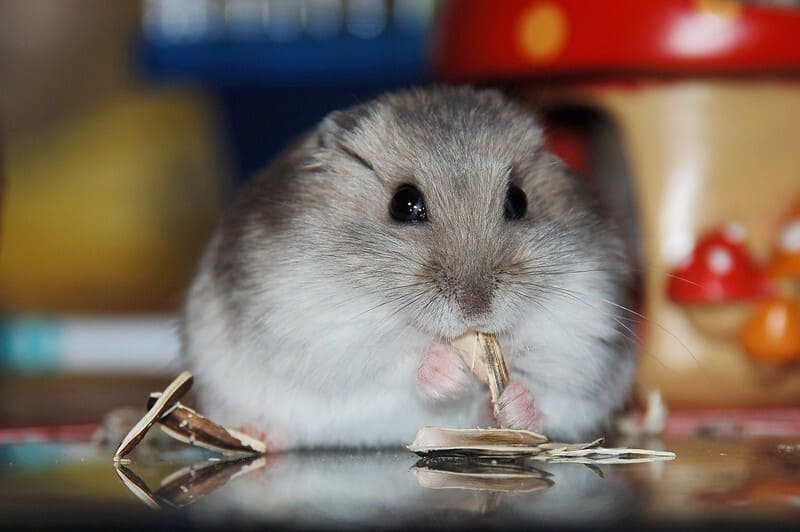Bringing a hamster into your life as a new pet is an exciting and rewarding experience. These small, furry creatures can make delightful companions when cared for properly. However, before acquiring a hamster, it’s essential to understand what to look for when buying one. This comprehensive guide will provide you with all the information you need to make an informed and responsible decision when getting a hamster as a pet.

Considerations Before Buying a Hamster
Before you even step into a pet store or contact a breeder, there are several important considerations you should keep in mind. These include:
1. Research the Species:
Hamsters come in various species, each with its unique characteristics. The Syrian hamster (Mesocricetus auratus) is the most common and also one of the largest, making them an excellent choice for beginners. Other species, such as dwarf hamsters (e.g., Roborovski, Campbell’s, and Winter White hamsters) and Chinese hamsters, are smaller and have different care requirements. Research the specific species you are interested in to ensure it aligns with your expectations and capabilities.
2. Determine Your Reason for Getting a Hamster:
Understanding why you want a hamster can help you choose the right type and prepare adequately. Do you want a low-maintenance pet, a companion for a child, or a more interactive and social pet? Your goals will influence your choice of species and how you set up their habitat.
3. Assess Your Commitment:
Hamsters have relatively short lifespans compared to other pets. Most hamsters live for about 2 to 3 years, so you need to be prepared for the commitment involved in caring for them throughout their lives. Consider your lifestyle, long-term plans, and whether you are ready for the responsibility.
4. Prepare the Habitat:
You must have an appropriate enclosure ready before bringing a hamster home. The habitat should include a comfortable bedding, a hamster wheel for exercise, hiding spots, a food dish, a water bottle, and chew toys. Make sure everything is set up and in place before acquiring your pet.
5. Choose a Reputable Source:
Selecting a trustworthy source to acquire your hamster is crucial. Avoid purchasing hamsters from places with poor living conditions or unethical breeding practices. Reputable breeders, rescue organizations, or responsible pet stores are better options.
What to Look for When Buying a Hamster
Once you are ready to acquire a hamster, there are several key factors to consider when selecting your new pet:
1. Health and Appearance:
When you visit a pet store or breeder to choose your hamster, observe the following signs of a healthy hamster:
- Active and Alert: A healthy hamster should be active, curious, and alert. It should move around its enclosure, explore, and interact with its environment.
- Clear Eyes: The hamster’s eyes should be bright and clear, without any signs of discharge, cloudiness, or redness.
- Clean Fur: The fur should be clean and well-groomed, without any patches of missing hair or signs of matting.
- Normal Breathing: The hamster should breathe quietly and without any audible wheezing or labored breathing.
- Active Grooming: Hamsters are diligent groomers. If a hamster appears unkempt or has a matted coat, it could be a sign of health issues.
- Active Eating and Drinking: A healthy hamster should eat and drink regularly. Check to ensure the food dish has been used, and the water bottle shows signs of consumption.
- Proper Weight: Feel the hamster’s body. It should have a well-rounded, plump appearance, indicating a healthy weight. Avoid hamsters that feel excessively thin or obese.
- Clean Rear End: The area around the hamster’s rear end should be clean and free from feces. Wetness or a dirty rear end could be a sign of diarrhea.
2. Age and Gender:
The age and gender of the hamster are essential considerations:
- Age: Young hamsters, typically around 6 to 8 weeks old, are the most common choice for new pet owners. At this age, they are more adaptable and easier to socialize. Older hamsters may be more challenging to tame and handle.
- Gender: If you plan to keep a single hamster, it’s generally recommended to choose a male hamster, as they are less territorial and more social than females. However, if you want to keep a same-gender pair or group, consider choosing littermates or hamsters raised together to reduce the risk of aggression.
3. Behavior and Temperament:
While you may not be able to fully assess a hamster’s temperament at the store or breeder, observe its behavior as much as possible. Look for hamsters that are:
- Curious: A curious hamster is more likely to be interactive and social.
- Friendly: While not all hamsters enjoy being handled, look for those that are willing to be gently held or petted.
- Non-Aggressive: Avoid hamsters that exhibit aggressive behavior, such as biting or lunging. Aggressive behavior may be indicative of a more challenging pet or an underlying issue.
4. Health History and Guarantee:
If possible, ask the seller or breeder about the hamster’s health history. Inquire about vaccinations, parasite control, and any previous health issues. Additionally, check if the pet store or breeder offers a health guarantee or return policy in case you encounter unexpected health problems shortly after bringing the hamster home.
5. Compatibility with Other Pets:
If you have other pets at home, consider their compatibility with a hamster. Some animals, such as cats and dogs, may view hamsters as prey. Ensure you have a safe and secure space for the hamster that prevents access by other animals.

Red Flags to Watch Out For
While there are several positive signs to look for when choosing a hamster, there are also red flags that should raise concerns. Avoid hamsters or situations that exhibit the following issues:
- Dirty or Unsanitary Living Conditions: If the hamsters are kept in unclean, overcrowded, or unsanitary enclosures, it may indicate poor breeding practices or neglect.
- Visible Signs of Illness: Hamsters that display visible signs of illness, such as lethargy, labored breathing, nasal discharge, or signs of injury, should be avoided.
- Highly Aggressive Behavior: A hamster that consistently displays aggressive behavior, such as biting or aggressive lunging, may not be suitable as a pet, especially for children.
- Hesitation from the Seller: If the seller or breeder is hesitant to provide information about the hamster’s health history, age, or origin, it’s a cause for concern. Transparency is essential when acquiring a pet.
- Unsocialized or Fearful Behavior: Hamsters that are excessively fearful, skittish, or unsocialized may require more time and effort to become comfortable with handling and human interaction.
Where to Buy a Hamster
Once you’ve decided to bring a hamster into your home, you need to determine where to acquire your new pet. There are several options, each with its advantages and disadvantages:
1. Pet Stores:
Pet stores are a common source for hamsters. They offer convenience and a wide selection of hamster species and coat colors. However, the quality of care provided to hamsters in pet stores can vary widely. Some pet stores may not prioritize the health and well-being of their animals.
When buying from a pet store, consider the following:
- Visit several pet stores and compare the conditions of the hamsters and the knowledge of the staff.
- Ask about the hamster’s age, health history, and return policy.
- Look for signs of good care, including clean enclosures and well-maintained living conditions.
2. Breeders:
Responsible hamster breeders focus on the health and well-being of their animals. They are knowledgeable about the specific species they breed and can provide information about the hamster’s background, health history, and lineage.
When buying from a breeder, consider the following:
- Research local hamster breeders through online forums, hamster clubs, or recommendations from other pet owners.
- Visit the breeder’s facilities to assess the living conditions and the overall health of the hamsters.
- Ask about the breeder’s practices, including socialization efforts and any health guarantees.
3. Animal Shelters and Rescues:
Some animal shelters and rescues may have hamsters available for adoption. Adopting from a shelter or rescue can provide a loving home to a hamster in need and may offer a more cost-effective option compared to purchasing from a breeder or pet store.
When adopting from a shelter or rescue, consider the following:
- Ask about the hamster’s background, history, and any health issues.
- Inquire about the adoption process and fees.
- Ensure the shelter or rescue provides a safe and clean environment for their animals.

Preparing for Your New Hamster
Once you’ve chosen your hamster and are ready to bring them home, there are a few essential steps to take to ensure a smooth transition for your new pet:
1. Prepare the Habitat:
Make sure your hamster’s enclosure is fully set up and ready before bringing them home. The habitat should include bedding, hiding spots, a food dish, a water bottle, a hamster wheel, and chew toys. Ensure the enclosure is safe and secure, preventing any potential escapes.
2. Choose the Right Food:
Research and purchase a suitable hamster food that meets your pet’s dietary requirements. Hamsters are omnivores and need a balanced diet of commercial hamster pellets and fresh fruits and vegetables. Avoid feeding them sugary or fatty treats, as these can lead to health problems.
3. Socialization and Handling:
Be patient with your new hamster and allow them time to acclimate to their new environment. Hamsters may be shy at first, so approach them gently and handle them with care. Gradually increase the frequency and duration of interactions to build trust and socialize your pet.
4. Regular Veterinary Care:
Schedule a veterinary check-up for your new hamster shortly after bringing them home. Regular vet visits are essential for monitoring your pet’s health and addressing any potential medical concerns. Ensure you have a knowledgeable and experienced exotic animal veterinarian.
5. Provide Mental Stimulation:
Hamsters are intelligent and curious animals. To keep them mentally stimulated, provide toys and activities that encourage exploration and engagement. These can include tunnels, climbing structures, and puzzle feeders.
6. Maintain a Regular Cleaning Schedule:
Regularly clean your hamster’s enclosure to ensure a clean and hygienic living environment. Spot-clean soiled bedding daily and perform a full cage cleaning at least once a week. This helps prevent odors and maintains your pet’s health.
Conclusion
Bringing a hamster into your life can be a rewarding and enjoyable experience, provided you make an informed and responsible decision when acquiring your new pet. Consider your reasons for getting a hamster, choose the right species, and select a reputable source from which to acquire your furry friend. Pay attention to the hamster’s health, behavior, and temperament, and ensure you are fully prepared for the commitment of caring for a pet with a relatively short lifespan.
With proper care, socialization, and a well-prepared habitat, your hamster can become a beloved member of your family, bringing joy and companionship to your life.
